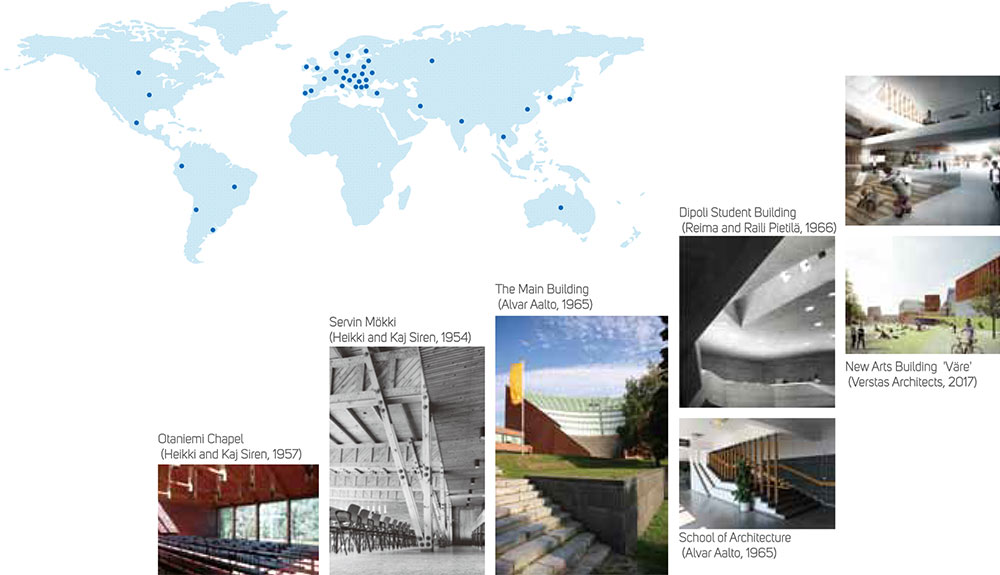
アアルト大学のウッド・プログラムは建築学科のデザイン&ビルドのスタジオ ・ゼミとして1994年に始まった。そして2001年には講義と演習旅行、ワークショップ形式の演習を組み合わせた1年間のプログラムとなり、フィンランドの建築環境に囲まれて木造を学びたいという世界各国からの学生たちを惹きつけるようになったのである。
アアルト大学建築学科に設けられたこのプログラムで、学生たちは木造建築の全体像を体験し、環境的、技術的、そして建築的に木材の特性をつかむことになる。このプログラムは森に生える一本の木に始まり、9 か月後には実験的な木造の建物を竣工して終わる。その間常に演習と実際の施工を通じて学ぶことに重点が置かれている。小さなデザインの課題から実際のスケールで建てるまでに至る学習は学生たちが今後、敷地と状況に応じてプロジェクトを遂行していくのに必要な技術と知識をつくりあげる。

第二次世界大戦をきっかけにヘルシンキ工科大学(現アアルト大学)はヘルシンキの中心部からオタニエミに移転した。フィンランドの建築家の中でも名高い、アルヴァ・アアルトがオタニエミ・キャンパスのマスタープランに加えて管理棟の建物もデザインして、1965 年に竣工している。
その数年後にはアアルトの手による建築学科や図書館本館などを含むその他の建物も完成した。その後もフィンランドの第一線の建築家たちによって数多くの建物が増築されており、その中には学生会館のディポリ(レイマ&ライリ・ピエティラ、1966年竣工) や、オタニエミ・チャペルと直会所(ヘイッキ&カイヤ・シレン、1957年竣工) などがあり、現在も新たにアート棟がヴェルスタス・アーキテクツの設計で建築されている。

The Wood Program began at Aalto University in 1994 as a design+build studio in the Department of Architecture. In 2001 it was expanded into a year-long curriculum of lectures, excursions and workshop exercises that attracts students from around the world who come to study wood in a Finnish architectural environment.
Centered in the Department of Architecture at Aalto University, the program introduces students to the ecological, technical and architectural properties of the material through an all-round view on the chain of wood construction. The program begins with a tree in the forest and ends nine months later with the opening of an experimental wooden building. Throughout this time, emphasis is placed on learning achieved through practice and execution. Small design tasks and full scale studies help the students build skills and knowledge to execute projects for sites and situations.

Following World War II, the Helsinki University of Technology (now Aalto University) moved its facilities from central Helsinki to Otaniemi. Renowned Finnish architect Alvar Aalto designed the campus plan as well as the main administrative building which opened in 1965.
Other buildings including the School of Architecture and the main library were completed in subsequent years by Aalto and numerous other buildings were added by other prominent architects including the Dipoli student center (Reima and Raili Pietilä, 1966) the Otaniemi Chapel and Servin (Heikki and Kaija Sirén, 1957) and the new Arts building currently under development by Verstas architects.